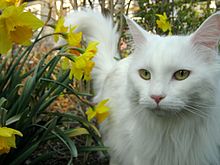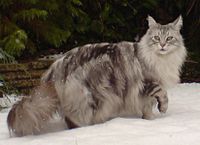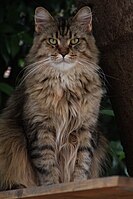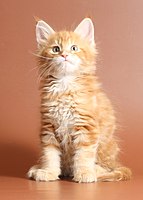Maine Coon
| Maine Coon | |
|---|---|
 A Maine Coon cat | |
| Other names | Coon Cat Maine Cat Maine Shag American Longhair[1] American Coon Cat American Forest Cat[2] |
| Common nicknames | Gentle giants |
| Origin | |
| Breed standards | |
| CFA | standard |
| FIFe | standard |
| TICA | standard |
| ACF | standard |
| ACFA/CAA | standard |
| CCA-AFC | standard |
| GCCF | standard |
| Domestic cat (Felis catus) | |
The Maine Coon is a large domesticated cat breed. One of the oldest natural breeds in North America, the breed originated in the U.S. state of Maine,[3][4] where it is the official state cat.
The Maine Coon is a large and social cat, commonly referred to as "the gentle giant." The Maine Coon is predominantly known for its size and dense coat of fur which helps it survive in the harsh climate of Maine. The Maine Coon is often cited as having "dog-like" characteristics.[5][6]
History
[edit]The Maine Coon is one of the largest domesticated cats. It has a distinctive physical appearance and valuable hunting skills. The breed was popular in cat shows in the late 19th century, but its existence became threatened when long-haired breeds from overseas were introduced in the early 20th century. The Maine Coon has since made a comeback, in 2023 the Maine Coon overtook the Exotic, becoming the second most popular pedigree cat breed in the world.[7]
Origin
[edit]Myths
[edit]Maine Coon cats originated in Maine. However, their lineage is surrounded by mystery, folk tales, and myths. One myth claims the Maine Coon cat is a hybrid with another animal species, such as the raccoon or bobcat. The second myth states the cats are descendants of Viking ship's cats, known today as the Norwegian Forest cats. A third story involves Marie Antoinette, the Queen of France who was executed in 1793. The story goes that before her death, Antoinette attempted to escape France with the help of Captain Samuel Clough. She loaded Clough's ship with her most prized possessions, including six of her favorite Turkish Angora or possibly Siberian cats. Although she did not make it to the United States, all of her pets managed to reach the shore of Wiscasset, Maine, safely, where they bred with other short-haired breeds and developed into the modern breed of the Maine Coon.[8][9]
Science
[edit]These myths and theories have long speculated that the long-haired Maine Coon cat has to be related to other long-haired breeds, due to their similarities in phenotype. For the Maine Coon in particular, that it is descended from the Norwegian or Siberian Forest cat, brought to New England by settlers or Vikings.[8][9][10] Phylogenetic studies showed that the Maine Coon belongs to the Western European monophyletic cat branch, but forms the closest relationship with the random-bred cat population in the Northeastern US (New York region).[11] This Western European branch contains the Norwegian and Siberian Forest cat, but they fall under a different sub-branch.[9]
Maine Coons are descendants of cats brought to New England by Puritan settlers in the 1600-1700s, and out of the European cats they are genetically closest to cats found in the United Kingdom.[9] It is not relatedness that makes them look similar to the Norwegian and Siberian Forest cats, but convergent evolution. These breeds all formed in harsh climates, in which natural selection pressures for similar qualities.[9] Thick, long coats, toe and ear tufts, big bodies, and snowshoe-like big feet, are useful traits in all the harsh climates where these breeds originate from.
Cat shows and popularity
[edit]

The first mention of Maine Coon cats in a literary work was in 1861, in Frances Simpson's The Book of the Cat (1903). F.R. Pierce, who owned several Maine Coons, wrote a chapter about the breed.[12] During the late 1860s, farmers located in Maine told stories about their cats and held the "Maine State Champion Coon Cat" contest at the local Skowhegan Fair.[13]
In 1895, a dozen Maine Coons were entered into a show in Boston. On 8 May 1895, the first North American cat show was hosted at Madison Square Garden in New York City. A female Maine Coon brown tabby, named Cosey, was entered into the show. Owned by Mrs. Fred Brown, Cosey won the silver collar and medal and was named Best in Show.[13] The silver collar was purchased by the Cat Fanciers' Association (CFA) Foundation with the help of a donation from the National Capital Cat Show. The collar is housed at the CFA Central Office in the Jean Baker Rose Memorial Library.[13]
In the early 20th century, the Maine Coon's popularity began to decline with the introduction of other long-haired breeds, such as the Persian, which originated in the Middle East. The last recorded win by a Maine Coon in a national cat show for over 40 years was in 1911 at a show in Portland, Oregon. The breed was rarely seen after that. The decline was so severe that the breed was declared extinct in the 1950s, although this declaration was considered to be exaggerated and reported prematurely at the time.[by whom?] The Central Maine Cat Club (CMCC) was created in the early 1950s by Ethylin Whittemore, Alta Smith, and Ruby Dyer in an attempt to increase the popularity of the Maine Coon. For 11 years, the CMCC held cat shows and hosted exhibitions of photographs of the breed and is noted for creating the first written breed standards for the Maine Coon.[13]
The Maine Coon was denied provisional breed status—one of the three steps required for a breed not yet recognized by the CFA to be able to compete in championship competitions[14]—by the CFA three times, which led to the formation of the Maine Coon Cat Club in 1973. The breed was accepted by the CFA under provisional status in May 1975, and was approved for championship status in May 1976. The next couple of decades saw a rise in the popularity of the Maine Coon, with championship victories and an increase in national rankings. In 1985, the state of Maine announced that the breed would be named the official state cat.[15]
Description
[edit]

Fur coat
[edit]The Maine Coon is a long- or medium-haired cat. The coat is soft and silky, although texture may vary with coat color. The length is shorter on the head and shoulders and longer on the stomach and flanks, with some cats having a leonine ruff around their neck. Minimal grooming is required for the breed compared to other long-haired breeds, as their double coat is mostly self-maintaining owing to a light-density undercoat. The coat is subject to seasonal variation,[16] with the fur being thicker in the winter and thinner during the summer.

Maine Coons have several physical adaptations for survival in harsh winter climates. Their dense water-resistant fur is longer and shaggier on their underside and rear for extra protection when they are walking or sitting on top of wet surfaces of snow or ice.[17] Their long and bushy raccoon-like tail is resistant to sinking in snow, and can be curled around their face and shoulders for warmth and protection from wind and blowing snow. It can even be curled around their backside like an insulated seat cushion when sitting down on a frozen surface.[18]
Large paws facilitate walking on snow and are often compared to snowshoes.[17] Long tufts of fur growing between their toes help keep the toes warm and further aid walking on snow by giving the paws additional structure without significant extra weight.[18] Heavily furred ears with extra long tufts of fur growing from inside can keep warm more easily.[17]
Coat colors
[edit]Maine Coons can have any colors that other cats have. Colors indicating crossbreeding, such as chocolate, lavender, the Siamese pointed patterns or the "ticked" patterns, are not accepted by some breed standards. This is not universal; the ticked pattern, for example, is accepted by TICA and CFA.[13] The most common pattern seen in the breed is brown tabby.[19] All eye colors are accepted under breed standards, with the exception of blue or odd-eyes, i.e. heterochromia iridium (two eyes of different colors), in cats possessing coat colors other than white.[16]
Size
[edit]
The Maine Coon was considered the largest breed of domestic cat until the introduction of the Savannah cat in the mid-1980s, yet it is still the largest non-hybrid breed.[citation needed] On average, males weigh from 18 to 22 lb (8.2 to 10.0 kg), with females weighing from 12 to 15 lb (5.4 to 6.8 kg).[20] The height of adults can vary between 10 and 16 in (25 and 41 cm) and they can reach a length of up to 38 in (97 cm), including the tail, which can reach a length of 14 in (36 cm)[21] and is long, tapering, and heavily furred, almost resembling a raccoon's tail. The body is solid and muscular, which is necessary for supporting their weight, and the chest is broad. Maine Coons possess a rectangular body shape and are slow to physically mature; their full size is normally not reached until they are three to five years old, while other cats take about one year.[22][better source needed]
In 2010, the Guinness World Records accepted a male purebred Maine Coon named "Stewie" as the "Longest Cat", measuring 48.5 in (123 cm) from the tip of his nose to the tip of his tail. Stewie died on February 4, 2013, from cancer at his home in Reno, Nevada, at age 8.[23][24] As of 2015 the living record-holder for "Longest Cat" is "Ludo", measuring 46.59 in (118.3 cm). He lives in Wakefield, England, in the United Kingdom.[25] Large Maine Coons can overlap in length with Eurasian lynxes, although with a much lighter build and lower height.[26]
Polydactylism
[edit]
Many of the original Maine Coon cats that inhabited the New England area possessed a trait known as polydactylism (having one or more extra toes on a paw).[17] With the 1970s revival of the interest in the breed, Maine Coon cats were noted to show an increased incidence of polydactylism compared to other breeds. Subsequently, breeders of show-standard cats were advised to regard this variation as undesirable and to offer affected kittens as household pets. The trait later became separately certified by some organizations, like The International Cat Association (TICA).[27] Meanwhile, in increasing numbers of cat fancy competitions, the trait is no longer marked down.
Polydactylism is rarely, if ever, seen in Maine Coons in the show ring, since it is not allowed by competition standards.[28] The gene for polydactylism is a simple autosomal dominant gene.[29] The polydactylism results from genetic problems which are not encouraged for breeding.[30] Polydactyly in Maine Coon cats is characterised by broad phenotypic diversity.[31] Polydactyly not only affects digit number and conformation, but also carpus and tarsus conformation.[32] The trait was almost eradicated from the breed due to the fact that it was an automatic disqualifier in show rings.[33] Some private organizations and breeders were created in order to preserve polydactylism in Maine Coon cats.
Health
[edit]Life expectancy
[edit]Pet insurance data obtained from a study during years 2003–2006 in Sweden puts the median lifespan of the Maine Coon at > 12.5 years. 74% lived to 10 years or more and 54% lived to 12.5 years or more.[34] A UK study found a life expectancy of 9.71 years compared to 11.74 years overall.[35]
Heart
[edit]
Hypertrophic cardiomyopathy (HCM) has been observed in Maine Coon populations.[36] A mutation in the MYBPC3 gene found in Maine Coons has been associated with HCM.[37]
Of all the Maine Coons tested for the MyBPC mutation at the Veterinary Cardiac Genetics Lab at the College of Veterinary Medicine at Washington State University, approximately one-third tested positive.[38] Not all cats that test positive will have clinical signs of the disease, and some Maine Coon cats with clinical evidence of hypertrophic cardiomyopathy test negative for this mutation, strongly suggesting that a second mutation exists in the breed. The HCM prevalence was found to be 10.1% (95% CI 5.8 -14.3%) in this study.[39] Early growth and nutrition, larger body size, and obesity may be environmental modifiers of genetic predisposition to HCM.[40]
Kidney
[edit]Polycystic kidney disease (PKD) is an inherited condition in cats that causes multiple cysts (pockets of fluid) to form in the kidneys. These cysts are present from birth. Initially, they are very small, but they grow larger over time and may eventually disrupt kidney function, resulting in kidney failure. While renal cysts are observed with a low incidence in Maine Coons, PKD appears to be a misnomer in this particular breed. In a 2013 study, spanning 8 years, renal cysts were documented by ultrasound in 7 of 187 healthy Maine Coons enrolled in a pre-breeding screening programme. The cysts were mostly single and unilateral (6/7, 85.7%), small (mean 3.6 mm in diameter), and located at the corticomedullary junction (4/6, 66.7%). Thus, different in size, number, and location from those observed in Persian-related breeds. In the same study, all six Maine Coon cats with renal cysts tested negative for the PKD1 mutation, proving the disease in these cats to be unrelated to the PKD observed in Persians and related breeds. Gene sequencing of these cats failed to demonstrate any common genetic sequences. Gendron et al. found that 'Maine Coon PKD' represents a form of juvenile nephropathy other than PKD.[41]
Skeletal, joint and muscle
[edit]Hip dysplasia is an abnormality of the hip joint which can cause crippling lameness and arthritis. The cats most commonly affected with hip dysplasia tend to be males of the larger, big-boned breeds such as Persians and Maine Coons. The relatively smaller size and weight of cats frequently results in symptoms that are less pronounced.[42] X-rays submitted to the Orthopedic Foundation for Animals (OFA) between 1974 and 2011 indicates that 24.3% of Maine Coons in the database were dysplastic. Dysplasia was more severe in bilateral than unilateral cases and with increasing age.[43]
The Maine Coon is one of the more commonly affected breeds for spinal muscular atrophy. An autosomal recessive mutation in both the LIX1 and LNPEP gene are responsible for the condition in the breed.[44]
Other
[edit]Maine Coons also seem to be predisposed to develop entropion, mainly on the lateral aspect of the eyelids, which can lead to corneal irritation and ulceration, and may require surgery.[45]
Gallery
[edit]-
A blue tabby in snow
-
A black silver classic tabby
-
A 7-month-old black silver tabby male
-
A black silver blotched tabby male
-
A brown tabby
-
A 4-year-old female
-
An odd-eyed harlequin patterned black tortoiseshell and white male
-
A red tabby kitten with large paws
-
An 8-month-old cream silver tabby
-
A red blotched tabby
See also
[edit]- List of cat breeds
- Norwegian Forest cat – Breed of cat
- Siberian cat – Breed of domestic cat
- Puppy cat – Behavioral pattern found in domestic cats
References
[edit]- ^ Morris, Desmond (10 May 1999). Cat breeds of the world: A complete illustrated encyclopedia. Viking. p. 90. ISBN 9780670886395. Retrieved 28 June 2012.
- ^ "Maine Coon Cats". Animal-World. Archived from the original on 17 January 2017. Retrieved 24 December 2016.
- ^ "Breed information". Maine Coon Breeders & Fanciers Association. Archived from the original on 10 September 2019. Retrieved 26 October 2008.
- ^ "The Maine Coon: Cat Breed FAQ". www.fanciers.com. Retrieved 7 June 2024.
- ^ Robins, Sandy. "Training Day". Popular Cats Series. 2. Bow Tie Magazines: 118–125.
- ^ "Maine Coon". American Cat Fanciers Association. Archived from the original on 13 June 2024. Retrieved 18 November 2024.
- ^ "Drumroll, Please! The Cat Fanciers' Association (CFA) is Elated to Reveal the Top 15 Pedigreed Cat Breeds That Had Everyone Purring in 2023!". The Cat Fanciers' Association. 15 February 2024. Archived from the original on 20 July 2024. Retrieved 18 November 2024.
- ^ a b "History, Legends and Myths of the Maine Coon". Maine Coon Rescue. Archived from the original on 5 December 2008. Retrieved 26 October 2008.
- ^ a b c d e "Are Maine coon cats really from Maine?". 27 January 2023. Archived from the original on 27 January 2023. Retrieved 9 September 2023.
- ^ Turner, Pam (15 May 2022). "What is the Difference Between a Maine Coon, A Norwegian Forest Cat, and a Siberian?". www.catwiki.com. Archived from the original on 2 July 2022. Retrieved 16 June 2022.
- ^ Lipinski, Monika J.; Froenicke, Lutz; Baysac, Kathleen C.; Billings, Nicholas C.; Leutenegger, Christian M.; Levy, Alon M.; Longeri, Maria; Niini, Tirri; Ozpinar, Haydar; Slater, Margaret R.; Pedersen, Niels C.; Lyons, Leslie A. (January 2008). "The Ascent of Cat Breeds: Genetic Evaluations of Breeds and Worldwide Random Bred Populations". Genomics. 91 (1): 12–21. doi:10.1016/j.ygeno.2007.10.009. PMC 2267438. PMID 18060738.
- ^ Simpson, Frances (1903). Chapter 28: Maine Cats (PDF). Cassell & Company, Limited. pp. 325–331. Archived (PDF) from the original on 4 January 2011. Retrieved 27 October 2008. The Book of the Cat
- ^ a b c d e Frew, Gail. "Breed Article: America's First Show Cat – The Maine Coon Cat". Cat Fanciers' Association. Archived from the original on 6 June 2012. Retrieved 20 April 2012.
- ^ "Cat Breed Directory: New or Experimental Breeds". Animal Planet. Discovery Communications. Archived from the original on 13 June 2011. Retrieved 15 January 2009.
- ^ "Title 1, § 217: State Cat". Maine State Legislature. Archived from the original on 17 January 2019. Retrieved 7 December 2008.
The state cat shall be the Maine Coon cat.
- ^ a b "The ACFA Maine Coon Standard" (PDF). American Cat Fanciers Association. Archived (PDF) from the original on 5 July 2024. Retrieved 20 November 2024.
- ^ a b c d "The Maine Coon: Cat Breed FAQ". Cat Fanciers. 2003. Archived from the original on 3 November 2008. Retrieved 2 November 2008.
- ^ a b "The origin of the Maine Coon". PawPeds.com. The Scratch Sheet. 1976. Archived from the original on 29 June 2024. Retrieved 20 November 2024.
- ^ "Choosing a Maine Coon". PetPlace.com. Intelligent Content Corp. Archived from the original on 22 February 2015. Retrieved 2 November 2008.
- ^ "Maine Coon - TICA". Retrieved 20 November 2024.
- ^ "Maine Coon: A gentle giant" (PDF). Royal Canin. Archived from the original (PDF) on 23 July 2011. Retrieved 31 October 2008.
- ^ "Maine Coon cat" (PDF). Cat Fanciers Federation. Archived from the original (PDF) on 29 December 2009. Retrieved 25 October 2009.
- ^ "World's longest cat dies in Nevada". CBS News. Archived from the original on 6 February 2013. Retrieved 6 February 2013.
- ^ Valois, Erin (20 October 2010). "World's longest cat revealed (and other notable animal world records)". National Post.
- ^ "Longest domestic cat (living)". Guinness World Records. Archived from the original on 24 June 2017. Retrieved 21 June 2017.
- ^ Nowak, Ronald M. (1999). Walker's Mammals of the World. Vol. 2. Johns Hopkins University Press. p. 831. ISBN 0-8018-5789-9. Archived from the original on 19 April 2023. Retrieved 19 April 2023.
- ^ "Maine Coon Polydactyl Breeders". tica.org. 6 August 2018. Archived from the original on 4 August 2020. Retrieved 16 February 2020.
- ^ King, Lucinda. "So what happened to the Maine coon polydactyl?". Maine Coon Polydactyl International. Archived from the original on 19 November 2008. Retrieved 2 November 2008.
- ^ Grindell, Susan. "Polydactyl summary". Maine Coon Polydactyl International. Archived from the original on 6 December 2008. Retrieved 2 November 2008.
- ^ Grindell, Susan. "The effects of polydactyly". Maine Coon Polydactyl International. Archived from the original on 17 January 2008. Retrieved 2 November 2008.
- ^ Lange, Axel, Nemeschkal, Hans Leo, Müller, Gerd B. (2014) Biased polyphenism in polydactylous cats carrying a single point mutation: the Hemingway model for of digit novelty. Evolutionary Biology, 41 (2), 262–275, 29, 2014
- ^ Hamelin, Alexia; Begon, Dominique; Conchou, Fabrice; Fusellier, Marion; Abitbol, Marie (April 2017). "Clinical characterisation of polydactyly in Maine Coon cats". Journal of Feline Medicine and Surgery. 19 (4): 382–393. doi:10.1177/1098612X16628920. ISSN 1098-612X. PMC 11119636. PMID 26862149. S2CID 34145481.
- ^ Grindell, Susan. "Incidence [of polydactyly] in the original breed population and today". Maine Coon Polydactyl International. Archived from the original on 6 December 2008. Retrieved 2 November 2008.
- ^ Egenvall, A.; Nødtvedt, A.; Häggström, J.; Ström Holst, B.; Möller, L.; Bonnett, B. N. (2009). "Mortality of life-insured Swedish cats during 1999–2006: Age, breed, sex, and diagnosis". Journal of Veterinary Internal Medicine. 23 (6): 1175–1183. doi:10.1111/j.1939-1676.2009.0396.x. PMC 7167180. PMID 19780926.
- ^ Teng, Kendy Tzu-yun; Brodbelt, Dave C; Church, David B; O’Neill, Dan G (2024). "Life tables of annual life expectancy and risk factors for mortality in cats in the UK". Journal of Feline Medicine and Surgery. 26 (5). doi:10.1177/1098612X241234556. ISSN 1098-612X. PMC 11156239.
- ^ Kittleson, Mark D.; Meurs, Kathryn M.; Munro, Marcia J.; Kittleson, Judith A.; Liu, Si-Kwang; Pion, Paul D.; Towbin, Jeffrey A. (22 June 1999). "Familial Hypertrophic Cardiomyopathy in Maine Coon Cats". Circulation. 99 (24). Ovid Technologies (Wolters Kluwer Health): 3172–3180. doi:10.1161/01.cir.99.24.3172. ISSN 0009-7322. PMID 10377082.
- ^ Godiksen, Mia TN; Granstrøm, Sara; Koch, Jørgen; Christiansen, Michael (9 February 2011). "Hypertrophic cardiomyopathy in young Maine Coon cats caused by the p.A31P cMyBP-C mutation - the clinical significance of having the mutation". Acta Veterinaria Scandinavica. 53 (1). Springer Science and Business Media LLC: 7. doi:10.1186/1751-0147-53-7. ISSN 1751-0147. PMC 3044103. PMID 21306647.
- ^ "Frequently Asked Questions about the test for the Hypertrophic Cardiomyopathy Mutation". Washington State University. Archived from the original on 26 September 2008. Retrieved 21 November 2008.
- ^ "Myosin-Binding Protein C DNA Variants in Domestic Cats (A31P, A74T, R820W) and their Association with Hypertrophic Cardiomyopathy" (PDF). vetogene.it. Archived from the original (PDF) on 11 February 2015. Retrieved 4 November 2013.
- ^ Freeman, Lisa M; Rush, John E; Meurs, Kathryn M; Bulmer, Barret J; Cunningham, Suzanne M (21 September 2012). "Body size and metabolic differences in Maine Coon cats with and without hypertrophic cardiomyopathy". Journal of Feline Medicine and Surgery. 15 (2): 74–80. doi:10.1177/1098612x12460847. ISSN 1098-612X. PMC 5971105. PMID 23001953.
- ^ Gendron, Karine; Owczarek-Lipska, Marta; Lang, Johann; Leeb, Tosso (December 2013). "Maine Coon renal screening: ultrasonographical characterisation and preliminary genetic analysis for common genes in cats with renal cysts". Journal of Feline Medicine and Surgery. 15 (12): 1079–1085. doi:10.1177/1098612X13492164. ISSN 1098-612X. PMC 10816467. PMID 23735675. S2CID 43268867.
- ^ Cat Owner's Home Veterinary Handbook (3rd ed.). John Wiley and Sons. 2007. p. 359. ISBN 978-0-470-09530-0.
- ^ Loder, Randall T.; Todhunter, Rory J. (21 April 2017). "Demographics of hip dysplasia in the Maine Coon cat". Journal of Feline Medicine and Surgery. 20 (4): 302–307. doi:10.1177/1098612x17705554. hdl:1805/17463. ISSN 1098-612X. PMID 28430011. S2CID 4355779.
- ^ Oliver, James A.C.; Mellersh, Cathryn S. (2020). "Genetics". In Cooper, Barbara; Mullineaux, Elizabeth; Turner, Lynn (eds.). BSAVA Textbook of Veterinary Nursing (Sixth ed.). British Small Animal Veterinary Association. p. 131. ISBN 978-1-910-44339-2.
- ^ Kirk N. Gelatt, ed. (2021). Veterinary ophthalmology (Sixth ed.). Hoboken, NJ: Wiley. ISBN 978-1-119-44181-6. OCLC 1143827380.
Further reading
[edit]- Bass, Sharyn P. (1983). This Is the Maine Coon Cat. Neptune City, New Jersey: T.F.H. Publications. ISBN 0-87666-867-8.
- Hayman, Tracey K. (2001). Maine Coon Cat. Dorking, England: Interpret Publishing. ISBN 1-84286-011-9.
- Hornidge, Marilis (2002). That Yankee Cat: The Maine Coon. Gardiner, Maine: Tilbury House. ISBN 0-88448-243-X.
Lua error in Module:Navbox at line 535: attempt to get length of local 'arg' (a number value).










